WESTERN
STATES ROAD TRIP
September
10–October 13, 2007
I.
THE
BIG
PICTURE
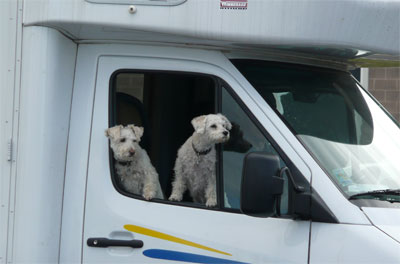
Our destination was
the southern
California town of Ojai to attend Hughes’s 50th Nordhoff High School
Reunion. To get there, we drove north through Wyoming and west to
Montana and Idaho, and across to Washington where we visited Hughes’s
sister’s
family in Spokane. From there we drove west and south along the coasts
of Oregon and California. Ojai is inland from Santa Barbara. After the
Reunion, we drove east across
the Mojave Desert, through Arizona and New Mexico, then north to
Colorado and
home. The trip lasted 34 days: we traveled 4,527 miles, stayed in 17
campgrounds, at the homes of five friends or family members, and we
parked our RV at the Woolsey
House in Ojai for 4 nights. Sophie and Bella looked forward to each
new day.
II. GOING
TO CALIFORNIA
WYOMING
We left Nederland the day
after Judy won her age group in the Neder-Nederland
5K for the 12th time. We descended Boulder Canyon through a thick
cloud with less than half a mile of visibility. Once we got to Boulder,
the sky cleared and we would see nothing but blue skies for the next
two weeks.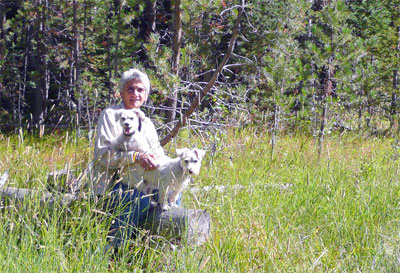
We reached southern Wyoming’s Snowy Range by early
afternoon and camped at South Brush Creek in
time to take the dogs on a 4-mile hike through a pine and aspen forest
interspersed with grassy meadows. There was no one else in the area: no
other campers, no moose, no elk, no deer. We had the forest all to
ourselves for the afternoon and evening. We enjoyed glasses of wine
around the campfire as the evening temperatures began to drop
with the setting sun. Before bed, we started a new gin rummy game that
would continue in the weeks ahead.
Just a few miles away is the
small town of Saratoga,
named after the town in New York famous for its “waters.” Wyoming’s
Saratoga has their “Hobo Hot
Springs,” a 24/7 free pool that was originally for cowboys coming
into town who needed relaxation and a place to make themselves
presentable for a night on the town. It continued
to be open during the Depression for anyone who needed to clean up. The
facility is operated by the town; the showers are clean, the water is
hot,
and it's one of the better hot springs we’ve been to. The rest of the
town
was a bit disappointing, though folks wanting to hunt, fish, canoe on
the
North Platte, and/or run their ATVs are well served, as are
the diners at the historic Wolf
Hotel. Shively’s Hardware store is a
throwback to what a real hardware store should be. (If you don’t know
what we mean, we couldn’t explain it.)
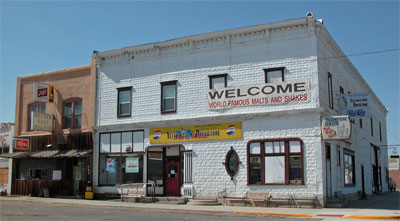
We made Cody the next
afternoon, but not without stopping at the famous Yellowstone
Drug Store in Shoshoni for
a milkshake (they sold over 20,000
shakes in the first six months of 2007; over 600 in one day!); a half
hour north through the Wind River Canyon we had a soak in the world’s
largest hot springs at Thermopolis.
We reached Cody in the
afternoon and chose to stay in town at the Ponderosa RV Park located
conveniently across from the Sierra Trading Post Outlet Store, a couple
of blocks from the Buffalo
Bill Historical Center, and less than a mile from downtown.
In contrast to Saratoga, Cody is a lively retail center built
around the life and myth of William “Buffalo Bill”
Cody. The Historical Center is, in fact, five museums under one
roof, a world-class facility that, in spite of all the Wild West
hoopla, should not be missed. We spent most of our time in the western
art wing which houses a rich and diverse collection of the best known
works by Moran, Bierstadt, Remington, Catlin, Russell, Dixon, and N.C.
Wyeth—truly great pieces that one sees only in art history books. Even
the section on the life and antics of Buffalo Bill were interesting and
worth viewing. We took in an entertaining musical review of cowboy
music and watched the
dreadfully silly “shoot out” in front of the historic Irma Hotel. The
time watching this so-called
“slice of the old west” on the street could have been better spent
getting a table at the hotel’s restaurant.
[Note: Just outside of Cody was the Heart Mountain
Relocation Camp, one of ten
WW II prisons housing Japanese Americans. From 1942–45 Heart Mountain
was the
third
largest city in Wyoming with over 11,000 temporary residents.]
MONTANA

President Theodore
Roosevelt
described the road along the Shoshone River between Cody and
Yellowstone National Park as the “most scenic 50 miles of highway in
the US.” (He’d probably not seen Colorado’s Million
Dollar Highway, or
Glenwood Canyon, or the Oregon/California coast. In fact, he should
have pointed out that it was only the last 15 miles east of Yellowstone
that
came close to being scenic. However, a good friend in Ohio fishes the
area religiously every summer, so there is some claim to fame. The full
50 miles would make a terrific bike route: wide, smooth shoulders,
and generally level.) As we approached the national park
entrance, traffic slowed to a halt, reminiscent of the days when bears
would successfully beg for food from tourists. The delay, however, was
for construction and we saw
no bears at all. We did see lots of bison and stopped with the rest of
the cars to take photos. We would have stopped for moose or elk or
wolves, but we didn’t see any.
We drove through the park to West
Yellowstone and up the Madison River valley to Ennis and west to
Virginia City, a gussied up
ghost town that retains all the flavor of
the fabulous gold rush town that brought unsuccessful miners from
California and Colorado in the 1860s in search of quick riches. (From
here there were only two fabulous gold rush destinations: Alaska and
Australia.)
The area around Alder Gulch is a
classic story of
boom and bust: There were about 5,000 residents in Virginia City when
it
incorporated in 1864, and 10,000 a year later; it was the territorial
capital from 1865–1875; but by 1869 there were only 100 folks living in
town. Today tourists bring “gold” 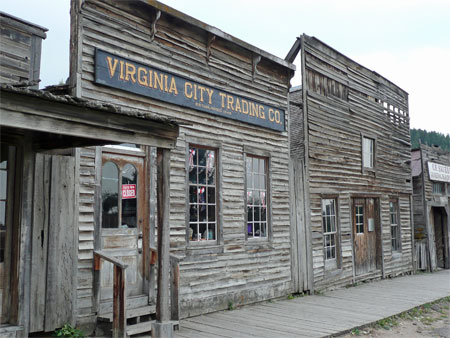 to the 150 or so who continue to
live
in this half-ghost town (or “town frozen in time” as the brochures
say). We found a lovely blend of restored and
original wood and brick buildings, friendly people, nice shops, a
beautiful back bar and mirror at the Pioneer Bar, and a visitor’s
center that once housed a narrow gauge railroad that originally hauled
gold
ore but today carries tourists a couple of miles to Nevada City and
back. Several of the old businesses along Wallace Street look like the
owners just packed up and left one day, leaving their goods and window
displays as they were.
to the 150 or so who continue to
live
in this half-ghost town (or “town frozen in time” as the brochures
say). We found a lovely blend of restored and
original wood and brick buildings, friendly people, nice shops, a
beautiful back bar and mirror at the Pioneer Bar, and a visitor’s
center that once housed a narrow gauge railroad that originally hauled
gold
ore but today carries tourists a couple of miles to Nevada City and
back. Several of the old businesses along Wallace Street look like the
owners just packed up and left one day, leaving their goods and window
displays as they were.
We drove up the valley of the
Ruby
River, stopped in Two Rivers
for fresh and delicious produce and baked
goods at a small farmer’s market, and pushed on to Anaconda
for a visit
with former Mystery Book Club member Wilma Burke who retired to this
former mining center where she grew up. Though Anaconda played an
important role in Montana mining history—almost becoming the capital,
losing in a controversial (some say dishonest) run-off election to
Helena—the town of 10,000 appears like it can’t decide to revitalize or
drift into apathetic oblivion.
Anaconda is justly proud of their
Washoe
Theater, a lovingly restored and still operating theater since
in opened in 1936. Built in the Art Deco style, it has been ranked by
the
Smithsonian Institute as the fifth most beautiful theater in the
nation. The theater is on the National Register of historic places. It
is remarkable and worth the price of admission (though Wilma arranged a
private guided tour). We also drove the Pintlar Scenic Route to
nearby
Phillipsburg, a former Victorian
era mining town with an attractive
fresh coat of paint. It is home of Doe Brothers Soda
Fountain that
serves fine homemade pasties and great milkshakes. Local sapphires can
be purchased either in gravel bags or polished at the Sapphire Gallery.
Just a mile outside
Phillipsburg
is the ghost town of Kirkville.
We climbed through the site which
features the Bi-Metallic Mining Company Mill, a gigantic, eight level,
150' x 400' foot monster with 100 stamps that were capable of
 crushing
200 tons of ore per day. The twin chimneys stand tall above
the trees and giant brick
furnaces on a massive granite foundation. The flue still carries water
and several of the camp’s buildings still stand.
crushing
200 tons of ore per day. The twin chimneys stand tall above
the trees and giant brick
furnaces on a massive granite foundation. The flue still carries water
and several of the camp’s buildings still stand.
North and west of Phillipsburg we
drove through Missoula and on
up the very scenic Highway 200 along the
Flathead River to Paradise and
a soak at Quinn’s
Hot Springs, a
relaxing way to end the day. We camped at Cascade N.F. Campground along
the banks of the Clark
Fork River, where Hughes gave the fish a good laugh before dinner. We
took the dogs on a hike the
following morning along an old wagon road, thick with larches, that
was used for hauling lead from a mine on the other side of the mountain
to barges on the river.
IDAHO
The valley of the Clark
Fork
became even more scenic as we drove toward the Idaho border through
Thompson Falls and Trout Creek. Finally we crossed over onto
the shore
of Lake Pend
Oreille (pon-duh-ray) past the small towns of Hope,
Kootenai (coo-ten-ee), and Ponderay (named for the lake but
spelled
phonetically for the tourists, we think) and into Sandpoint.
The women
at the Visitors Center were enthusiastic about a great RV park and the
Coldwater Creek outlet store in town. The visitor’s center folks were
chipper and smiling, but they were wrong on both counts. The RV park at
Travel America was scummy (though it was right across from a bike path
connecting to town five miles away) and the Coldwater Creek outlet
store closed some time ago! Oh, well…
Judy had a childhood girlfriend
who moved to Bonners Ferry in
the 1950s and was never heard from
again. The location always intrigued her and so we went to see what it
was like. We left Sandoint early in the morning for a dot on the map
just 25
miles from the Canadian Border. The small town of about 2,500, which
sits on the banks of the Kootenai River, came to life when Edwin Bonner
offered ferry service to gold hunters headed to Canada along the
Wildhorse Trail in the 1860s. After the gold rush, folks began cutting
trees and lumber became king. Today it caters to outdoor recreation
lovers and folks who want to get away from everything.
Close by is the Kootenai National
Wildlife Refuge, a 2700-acre sanctuary for geese, ducks,
mergansers,
coots, grouse as well as such big game as deer, elk, moose, black bear
and mountain lions. We spent several hours bicycling and hiking around
the 4.5-mile perimeter without seeing much except waterfowl and a lone
coyote.
[Note: We were surprised by the odd
meaning of the term “refuge”
takes here: Hunting, you see, is permitted. There are 21 blinds and
hunters can take their
retriever dogs can fetch fallen birds. Visitors, however, and their
dogs must keep to the perimeter road. Hunting is restricted to four
days a week, 25 shells per day. Big mammals—moose, bear, mountain
lions, deer, etc.—are fair game also. The refuge seems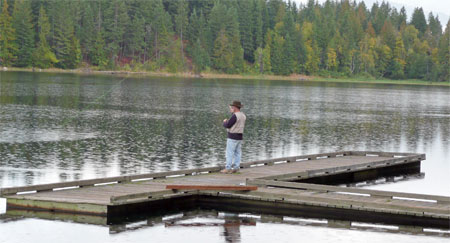 anything but a
place of sanctuary or safety, the usual meaning of the word refuge.
My nephew, Doug, who lives in Idaho, explained this apparent
contradiction to me a few days later: “That’s Idaho.” Are there other
“refuges” that permit/encourage hunting, or are we naive?]
anything but a
place of sanctuary or safety, the usual meaning of the word refuge.
My nephew, Doug, who lives in Idaho, explained this apparent
contradiction to me a few days later: “That’s Idaho.” Are there other
“refuges” that permit/encourage hunting, or are we naive?]
We enjoyed window shopping in
town: Bonners Books is a real
gem of a bookstore with good used and
rare books alongside regional books and best sellers; Larson’s
Department Store had a good sale on outdoor wear; there are
several
good health food stores and interesting cafes. We spent the night at
Smith
Lake just a few miles north of town (Smith Lake fish are also the
chuckling
variety). In the morning, Judy’s morning run was back towards
town
four miles to a roadside
fresh produce stand where we met and filled our refrigerator with good
fruits and veggies and home baked bread. We drove east a few miles to
Moyie Falls to buy some
homemade garlic knockers at the Moyie Store
(gas station, small engine repair, and grocery all in one) we’d read
about. We met and talked with George Elliot (age 71) and his wife
Shirley who came out of retirement to take over the business and offer
their secret recipe knockers to the public.
Farragut
State Park is located at
the southern end of Lake Pend Oreille past Sandoint near Bayview,
a picture postcard
village of sailboats and small houses on a small cove. During WW II the
Farragut Naval Training Center was second in size only to Chicago’s
Great Lakes Naval Training Center and home to as many as 33,000
sailors. The lake’s depth of over 1,000' made it appropriate for
submarine training as well as surface crafts. Today, few of the
structures remain; the brig is now the museum that displays the history
of what
took place there before the way and after. In addition to camping,
there are miles of trails 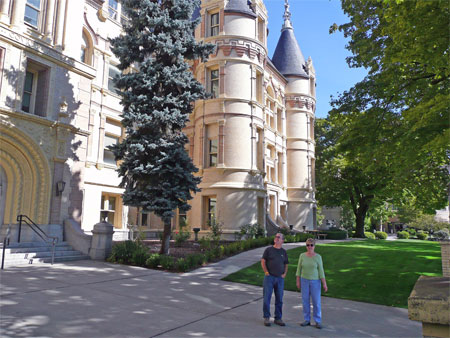 for
hiking and biking, plus fishing,
swimming,
lots of wildlife, and even an “airport” for model airplane buffs. The
3000-acre facility is one of the best state parks we found on the trip.
for
hiking and biking, plus fishing,
swimming,
lots of wildlife, and even an “airport” for model airplane buffs. The
3000-acre facility is one of the best state parks we found on the trip.
WASHINGTON
We had a great visit with
Hughes’s
sister Pam and her husband Nils, who live in an eastern suburb of
Spokane. They showed us the
best that the city has to offer: the
surprising castle-like county courthouse
(photo on left);
the lively Riverfront
Park complete with
a fabulous historic carousel; Auntie’s
Bookstore; and a drive through
some elegant older neighborhoods and botanic gardens that were still in
bloom in late September. On another day, they showed us Coeur
d’Alene
beginning with a farmer’s market where we met up with her daughter, a
granddaughter, and a great-grandson. After breakfast, we drove along
the Centennial
Bike Path that connects Coeur d’Alene with Spokane. We
walked along the north shoreline of Coeur d’Alene Lake and
window-shopped a few of the downtown blocks. Each night we played
Shanghai Rummy (west coast rules, of course).
One of the great benefits of their
move from the Ridgecrest in the Mojave Desert to western Washington, in
addition to
avoiding the heat, is that Pam and Nils are near Pam’s two children and
their families: two children (and spouses), four of her six
grandchildren (and their spouses), and her four great-grandchildren all
of who live just a half hour in Idaho. On the Sunday we were there,
the clan gathered at Pam and Nil’s (all but two who had to work). Such
an occasion is both a periodic event as well as a once-in-a-while
command performance
for the family to meet their aunt and uncle (or great-, or
great-great-aunt and uncle). We’d not seen some of them in 15
years. The changes were remarkable,
though no one said that we looked older! There was food for an army
(including garlic knockers) and lots of pictures taken. They are a
good-looking bunch and fun to be with. All in all, it was a terrific
visit.
hour in Idaho. On the Sunday we were there,
the clan gathered at Pam and Nil’s (all but two who had to work). Such
an occasion is both a periodic event as well as a once-in-a-while
command performance
for the family to meet their aunt and uncle (or great-, or
great-great-aunt and uncle). We’d not seen some of them in 15
years. The changes were remarkable,
though no one said that we looked older! There was food for an army
(including garlic knockers) and lots of pictures taken. They are a
good-looking bunch and fun to be with. All in all, it was a terrific
visit.
We left Spokane with the
ambitious intent
of
reaching the Columbia River near Longview by evening. The first few
hours on I-90
took us through a drab landscape. The
Columbia River Gorge at George was dramatic and we saw our first green
farmlands near Ellensburg, but
the landscape returned to tan grass and
volcanic rock all the way to Yakima
where we took Highway 12 towards
Mount Rainier
National Park. Finally, we entered the land of scenic
mountains and tall trees. We had begun to wonder where the state’s
nickname “The 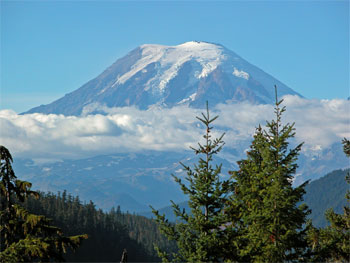 Evergreen
State” came from. As we came off White Pass
there was Mt. Rainier rising majestically from the surrounding hills.
What a beautiful and impressive sight, reminding us both of Jhomolhari
in Bhutan.
Evergreen
State” came from. As we came off White Pass
there was Mt. Rainier rising majestically from the surrounding hills.
What a beautiful and impressive sight, reminding us both of Jhomolhari
in Bhutan.
Camping in the national park
would
have been nice, but we had some hours left in the day and we pushed on
to Taidnapam,
a beautiful campground near Glenoma
on a
Cowlitz
River reservoir owned and operated by the Tacoma Public Utilities.
Rainier’s
campgrounds could not have been nicer; at Taidnapam we found thick
woods of
pine, fir, cedar, spruce, alder, maples, ferns and rhododendrons that
create a park that is both dark and peaceful. It was as beautiful as
any campground we have visited. As Judy often said on the trip, “To
heck with the schedule. Let’s stay another night or two here.”
OREGON
We didn’t. Instead
we got up early
and found our way to I-5 to Longview
and crossed the Columbia and
headed west to Astoria home
of John Jacob Astor’s Pacific Fur Company.
It is either “oldest American settlement west of the
Rockies” (Oregon Tourist Guide) or “the first permanent US settlement
on the Pacific Coast” (Wikipedia). Don’t count the Spanish or any
Native People as “American.” Oh, well, we know what they mean. The town
of just under 10,000 combines new and touristy places with the historic
buildings—bars, hotels, fishing supply stores, marinas—from the area’s
fishing past.
We didn’t linger but turned south
on US 101, which would be our route for the next few days. We did stop
at Seaside,
an attractive
year-round tourist destination: restaurants,
souvenir shops, fudge makers, bumper cars—you get the idea. There is a
prominent statue of Lewis and Clark down by the end of the town walkway
that identifies Seaside as the terminus of their journey. We skipped by
Cannon Beach (a bit too ritzy
and residential), though we did take
shots of famous Haystack Rock, which, though often shown in travel
booklets, is like a lot of other large monoliths that line the Oregon
coast. We also skipped Manzanita
and Nehalem, which we’d come
back to
on another trip.
next few days. We did stop
at Seaside,
an attractive
year-round tourist destination: restaurants,
souvenir shops, fudge makers, bumper cars—you get the idea. There is a
prominent statue of Lewis and Clark down by the end of the town walkway
that identifies Seaside as the terminus of their journey. We skipped by
Cannon Beach (a bit too ritzy
and residential), though we did take
shots of famous Haystack Rock, which, though often shown in travel
booklets, is like a lot of other large monoliths that line the Oregon
coast. We also skipped Manzanita
and Nehalem, which we’d come
back to
on another trip.
We spent our first night in
Oregon at Cape
Lookout State Park south of Tillamook. We had no
reservation but were
able to get the last site with hook-ups at 4:00. We parked 30 yards
from a wide, white sand beach where we turned Sophie and Bella loose to
run and enjoy the exotic beach smells—at last freedom from the
confinement
of riding most of the day in the RV. They had a ball! After dinner we
walked back to catch a typical gorgeous sunset. We hated to leave in
the morning.
Judy took a
morning run on a beautiful beach before we returned to Tillamook to
visit the Tillamook Cheese
Factory. We were astonished that
the price of cheeses made right there were more than what they would
cost at our local grocery. So we left promptly and spent an enjoyable
hour (and a few bucks) down the road at the Blue Heron French Cheese
Company, which had a better selection of both cheeses and wines.
The
Tillamook Cheese Factory visit is highly overrated and not worth the
time.
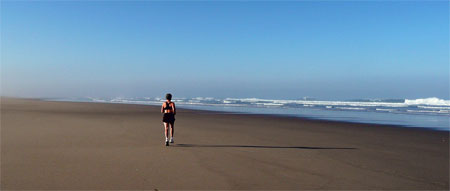
On the way south we stopped in Depoe Bay to watch whales
offshore. In Newport we searched for Mo’s
Annex, a highly regarded
restaurant but
couldn’t locate it easily. We nearly missed
a second Newport eatery, the Lighthouse Deli,
because it is now called
the South Beach Fish Company, but the chowder, Dungeness crab burgers,
and fish and chips are still outstanding. Yachats (yah-hoots) was less
impressive than the write-ups we read beforehand. We finally pulled
into Carl
Washburne State Park, found a nice site near the ocean access
trail, only to discover that the ocean was in fact two miles away with
huge
sand dunes to cross and lots of dune buggy traffic to dodge. So we left
and kept driving until we came to Umpqua Lighthouse
State Park: a nice
enough facility but still a distance from the ocean. But at 6:30 in the
evening we decided to stick it out.
After Judy’s morning run on the
beach (which we drove to), we visited
the Umpqua
River Lighthouse then drove down to the library at Coos Bay, the
largest town on the coast, to check email. Seventeen
miles later we “discovered” what might have been the most interesting
town of all along Oregon’s coast: Bandon.
We turned in to Bullard’s
Beach State Park, which looked like the best state park on the
coast
(lots of room between sites, full hook-ups, and near the beach and the
Coquille River).  We’ll go back there for sure. The Coquille
River
Lighthouse in the smallest of the eight remaining Oregon coast
lighthouses. We drove through the attractive town and out to the
highway via an area of posh beach homes that are being built as fast as
the guys can drive nails.
We’ll go back there for sure. The Coquille
River
Lighthouse in the smallest of the eight remaining Oregon coast
lighthouses. We drove through the attractive town and out to the
highway via an area of posh beach homes that are being built as fast as
the guys can drive nails.
We faced some tough decisions
concerning
the next few days: We had been driving more than we wanted and had not
really explored areas as much as we might ordinarily. We also were
constrained to a schedule. There were many lovely towns and beaches
along the Oregon (and California) coast to explore, but we had to get
to Mountain View (just south of San Francisco) in a few days and,
eventually, Ojai a few days after
that. We’d just have to miss some places, and skim over the others,
knowing a return trip was required. In the end we opted for speed: we
passed through Port Orford, Gold Beach (not
nearly as interesting as their brochures hyped the town), stopped in
Brookings where, after ignoring
countless shops in every town along the
south coast, we finally succumbed to buying a myrtlewood bowl (which we
need like another hole in our heads) as a souvenir of the trip.
CALIFORNIA
We thought we might spend
the night near Crescent City,
the only incorporated city in Del Norte County and just 20 miles below
the Oregon border. However, we decided to push on through
Redwood National Park, a very
scenic drive through towering groves of
the tallest trees in the world. We stopped at several turnouts to walk
through among the trees and to give the dogs a chance to romp.
We thought we might camp at the campground in the park, but found the
sites cramped together, not very flat, and no facilities—all for $20.
We pushed on to the first campground we came to outside the park where
the sites were level, lots of room for the dogs to roam, full hook-ups
and showers.
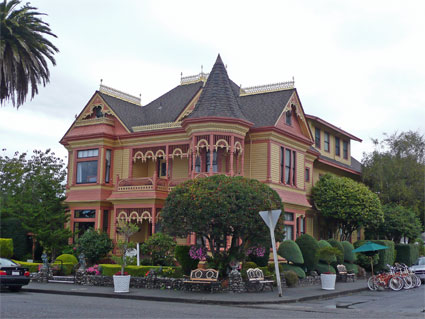
In the morning we experienced our
first real rain of
the trip (but since we aren’t in a tent, it’s no problem to unhook the
electric and water line in the rain). We drove through Arcata, home of
Humboldt State University, often
referred to as the hippy/party school
of the California state system, a reputation we can’t confirm. The
state visitor’s center did have a copy of George and Jan Roberts’
Discover
Historic California (Gem Guides, 2004) that describes all the
highway historical markers in the state (over 1,100 of them!) which
we often referred to throughout the trip. Just south of Arcata is Eureka,
home of
Victorian mansions and a pretty good co-op/grocery where we stocked up.
South of Eureka and five miles west of the highway across the Eel River
is Ferndale, a charming farming
village of Victorian homes (like The Gingerbread Mansion on
the left) and interesting
arty shops for the tourists who pass through here on their way to the
rugged Lost Coast at Cape Mendocino.
The Avenue of the Giants
parallels US 101 through
Humboldt Redwoods State
Park, a spectacular two-lane road that passes
through the dark, dense groves of redwoods. We passed the “Drive Thru
Tree,” the “One Log House,” and several galleries devoted to redwood
objects and carvings. All together, it is an area of the state and
country that should not be missed.
At Leggett we turned inland on
California
Highway 1,
rightfully famous for rugged scenery, windswept beaches, solitude, and
small coastal towns. The
drive over to the coast reminded us of Maui’s Road to Hana and any
paved road in Bhutan: twisting, narrow, no shoulder to speak of, and
few pullouts to let oncoming traffic (like logging trucks) get by. It
took nearly an hour to complete the 27 miles to the coast, but
the views from then on were worth every agonizing turn. We were two
hours driving the 40 miles to Fort
Bragg along an equally slow two-lane
highway, though the scenic coast was dramatic and beautiful.
Mendocino,
just a short drive south, is
one of the prettiest towns on the coast. The Victorian town overlooks a
rugged coastline and is a perfect place for visitors to walk through,
to shop, 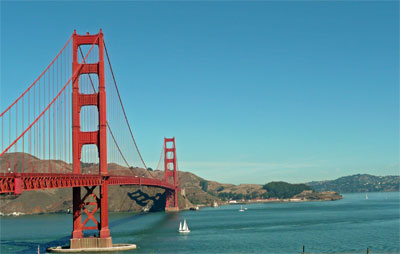 and to look for the house that was used in the opening
sequence of
the TV series “Murder She Wrote.” The show’s fictional setting
was Maine, but Jessica’s house was actually filmed in Mendocino. A
short drive from town is a network of paths for walking, biking, and
running. It was a sparkling day, so Judy ran while Hughes and dogs
walked along the edge of the steep cliffs watching the sea birds and
waves.
and to look for the house that was used in the opening
sequence of
the TV series “Murder She Wrote.” The show’s fictional setting
was Maine, but Jessica’s house was actually filmed in Mendocino. A
short drive from town is a network of paths for walking, biking, and
running. It was a sparkling day, so Judy ran while Hughes and dogs
walked along the edge of the steep cliffs watching the sea birds and
waves.
Traveling on Highway 1 is very
scenic, but very,
very slow: 15–20 mph in many sections. For relief, we turned inland to
Navarro and passed through Hendy Woods State Park,
which shelters a small redwood grove just before Boonville (where the
Boontling
dialect is fast fading). At Santa Rosa,
we returned to the coast
in
hopes of connecting with friends we met nine years ago in Copper
Canyon, Mexico, who live in Duncans
Mills, a wide place in the road
near Jenner. We missed
them by an hour (we found out weeks later)
but spent a pleasant night camping on the Russian River at Casini
Ranch, which was hosting an antique travel trailer rally.
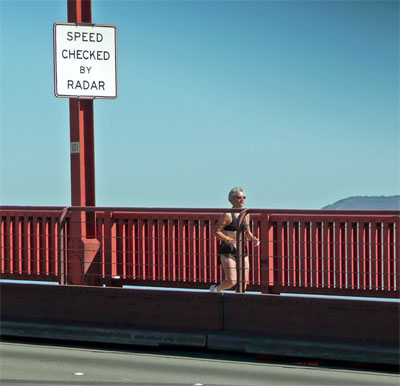
We agreed Judy should run across
the Golden Gate Bridge. Luckily, there was a nearby parking spot on the
south side of the bridge. Judy ran across and back while Hughes
biked the same route and took pictures of the event. The bridge is
only 1.7 miles each way, with lots of foot and bike traffic, a
constant gentle grade, whizzing cars, and gorgeous scenery. It was a
trip highlight.
We arrived at Cynthia’s house in
the early
afternoon, after passing Golden Gate Park, the Presidio, and the edge
of downtown San Francisco
along the Junipero Serra Highway, called by
some “The World’s Most Beautiful Freeway.” It runs atop the San
Andreas Fault (or Rift Zone as it’s now called). We stopped at Filoli,
a beautiful park/botanic garden and historic country estate near
Woodside (The house was used in
the opening scenes of TV’s “Dynasty.”)
My high school friend Cynthia
Sievers was the perfect hostess. Her invitation to visit gave us some
much needed breathing space.
The
two days were a
chance to slow our pace a bit, walk the Stanford campus, take the dogs
for a refreshing walk along the south bay with her granddaughter,
Haleigh, and have dinner with Darla Belshe, another high school friend,
and to
catch up on our past 50 years since high school—a sort of warm up for
the reunion that was less than a week away.
[Note: Hughes was relieved that both
Cynthia and Darla
had changed very little since high school. He
said that not
only would he recognize them at any time, anywhere, but also their
personalities have remained pretty much the same. It led him to think
that he hasn’t changed all that much either. They both warmed to Judy
immediately.]
We spent an extra day on the road
getting to Ojai:
we returned to California
Highway 1 at Monterey and
drove along the rugged
and isolated Big Sur coast. We spotted what looked at first like piles
of driftwood logs covering a stretch of beach. As we drew closer, the
“logs” turned into a colony of elephant
seals sunning themselves on the
sand. As few miles further we came to San
Simeon, where William
Randolph Hearst built this famous playhouse for his rich friends, the
well-connected, and his mistress.
where William
Randolph Hearst built this famous playhouse for his rich friends, the
well-connected, and his mistress.
The Hearst Castle is
overwhelming in many ways: its
location five miles from the highway and 1600’ above the ocean could
not be more impressive; the opulence of the buildings and the interiors
is both spectacular and over the top; and the art and architecture that
make up the buildings and grounds would have put Louis XIV to shame.
Much of Hearst’s original 250,000 acres, “given over” to Americans by
the Mexican government in the 19th century and purchased by Hearst’s
father, had been sold off by Hearst Jr to repay nearly $150 million
debt he’d piled up by the mid-1930s. There are currently a mere
82,000 acres which the Hearst family gave to the state of California.
Of course
the Hearst family can use the grounds and buildings whenever they wish;
state employees working there are permitted to swim in the pool once a
year for two hours. The rest of us pay $20 to tour the grounds. “The
Castle” is the ultimate extravagant self-indulgence of the American
aristocracy that is not likely to be seen again.
[Note: Hearst already had owned a
castle in Wales
and this California estate is technically “The Hearst Ranch.” Cattle
are
still raised on the ranch and the beef sold at the visitor’s center.]
We spent the night at San Simeon
State Park and woke to glorious
sun and the sound of the ocean. We headed south looking for a good
stretch of road or beach for Judy’s morning run. We picked Cayucos, a
lovely seaside resort town just north of Morro Bay. Lunch was, of
course, split
pea soup in Buellton
at Anderson’s. Finally, the last leg
of our journey on US 101 took us through Gaviota Pass to the coast,
past Santa Barbara to Carpenteria (Hughes spent lots of
summer days at
the beach there), and over highway 150 past Lake Casitas to Ojai.
III. HUGHES’S 50th HIGH SCHOOL REUNION
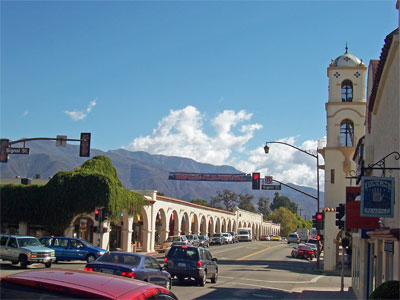
The high school
reunion in Ojai was a grand affair and a
wonderful three days of memories. For those readers interested in what
a group of just over 100 senior citizens might do for fun, the account
of the gathering of the Nordhoff High School class of ’57 is written up
on a separate
site.
[Note:
The the town was incorporated as Nordhoff in the 1870s, named for noted
writer Charles
Nordhoff of Mutiny on the Bounty
fame. The high school was naturally named after the town.
However, during WW I the name of the town was summarily renamed Ojai, a Chumash word that probably
means “moon,” though local lore has it that it means “nest.” The
name change was accomplished either through the efforts of a local
businessman, an edict by then Senator James D. Phelan, or because of
prevalent anti-German sentiment—or all three. In any case, the high
school retained the name Nordhoff. For more on the history of Ojai, see
The Ojai Valley:
An Illustrated History by Patricia L. Fry (Matilija Press,
1983).]

Hughes’s high school reunion
coincided
with a
mini-reunion with the two couples we reconnect with every year: Lee
and Irene, and Tom and Loretta. We had only two days together, but it
was enough to catch up on the past year, to wish Tom and Loretta bon
voyage on their around the world trip of a lifetime later in
October,
and to look forward to a more extensive reunion trip
next year. An Alaskan cruise, perhaps?
IV.
COMING HOME
CALIFORNIA
We left Ojai and drove
through Santa Paula where
Hughes lived from 1945–52. We found his old house on Manzanita Drive.
We also drove
by McKevett Elementary School (where he attended grades 1–5) to see how
little
it had changed (new
paint and tile roof plus lawn on the playground instead of dirt and
rocks). We passed Fillmore
(Hughes lived there 1944-45) and Piru,
home of the best oranges in the world (Hughes
started school there in 1945), and finally across
the Mojave Desert to Needles.
It was the first time either of us had crossed the
desert during the daytime. In the old days, you crossed at night
so the engine wouldn’t boil over!
ARIZONA
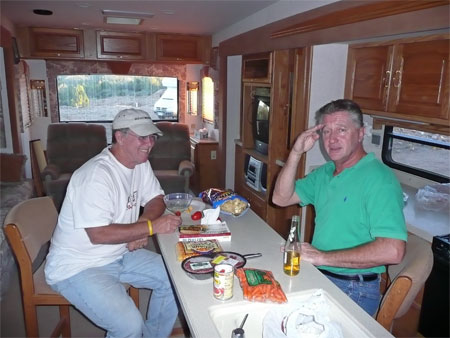
We planned to visit with an old friend who has since moved to Arizona.
He lives well off the grid which required us to call for directions and
have him meet us at an agreed-upon location so he could guide us to his
new place. He was where he promised he’d be with his ATV and we
followed him nearly four miles over dirt roads and washed out stream beds
to his home site. We stayed with him the following two nights. He
hasn’t begun to build his house (school tax issues that have yet
to be resolved), though he has finished a good-sized storage shed next
to the fifth-wheel, his home until the house is completed. His solar
panels and storage batteries are in place, plus, of course, his well
and septic. Theres not a lot to do out in the middle of nowhere; we
talked a lot, drank beer, barbequed, and hiked
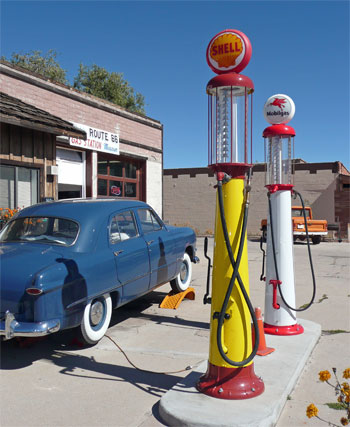 his property.
his property.
We stopped in Williams as we continued our way
east.
Williams
is
still living in the 1950s astride Route 66. It’s an attractive retro
town that lives on aging tourists who like to reminisce about driving
the “Mother
Road,” plus those who want to take the 60-mile train ride
to the south rim of the Grand Canyon. It has hills, some tall trees,
and some elevation. We thought we could live there.
Holbrook
is another town trying to appeal to
Mother Road nostalgia—though it appears not hard enough nor
successfully. The classic Wigwam Motel (with
a 1950s car parked in
front of each cement teepee) looked to be out of business, and Joe and
Angie’s café is looking the worse for wear. Several other
downtown businesses looked closed. The OK RV campground was more OK
than the KOA and less expensive to boot, so we stayed there. However,
there’s not much to
do in Holbrook, unless you’re headed to the Petrified Forest.
NEW MEXICO
Albuquerque was our last stop and an
opportunity to visit our former Ohio neighbor, Anna Marie Peterson. By
chance, we arrived
during the annual Hot
Air
Balloon Fiesta, the largest gathering of hot air balloons in the
world.
We didn’t plan on it, but we were very glad our visit overlapped with
the event. Anna Marie had always urged us to come down for the fiesta
and stay
with her, but we’d never taken her up on the offer. Good heavens,
what we missed! We didn’t expect to be so overwhelmed by the experience.
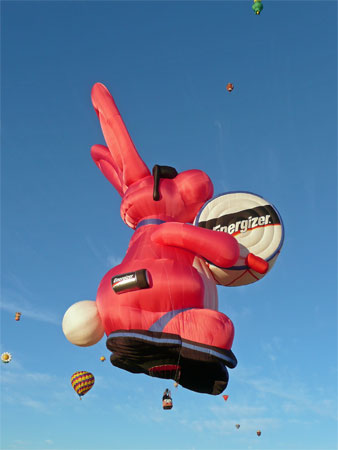
Anna Marie, who volunteers at the
Balloon Museum,
got us up at 4:15 am to feed and walk the dogs, and took us to the
Balloon Fiesta Park at 5:30 am! By the time we bought our tickets and
got a golf cart shuttle ride to the field, the first balloon had
already ascended. His task was to test the currents and wind speeds and
give the pilots on the ground that information. We walked from one
balloon crew to another, watching them unfold the balloons, attach the
lines and the baskets, and get all the preparations ready for their
launch. Most of the ones we watched were “special shape” balloons, of
which there were about 90 this year. There were over 900 regular
tear-shaped balloons also. In a highly organized program, just before
the sun rose over the Sandia Mountains, the balloons were called to
ascend. And what a spectacle it was! In less than an hour, nearly 1,000
balloons ascended above and around us—first the special shapes
followed by the regular balloons.
There is, we learned, something
called “the
Albuquerque box,” a series of currents at different altitudes that
permits a balloon to ascend, drift (on this day) south, then rise and
reverse direction, descend to the original altitude and drift
back to the south. In this manner, expert pilots can go back and forth
(at different altitudes) over a selected area. This allows for pilots
to compete for prizes by reaching out of their basket for an envelope
on the end of a five-foot pole, or dropping a marker on a target inside
the field. By going back and forth the pilots have two or three or more
chances for each. The skill involved is remarkable.
More overwhelming was the
dazzling array of colors
constantly drifting overhead for the next three hours: different
shapes,
different designs, and a rainbow of color. We could have taken
hundreds of photos. It was a remarkable morning and another trip
highlight.

We shopped at an Albuquerque Trader Joe’s, the best food
store in
the world, on the way back. We had a wonderful lunch at Anna
Marie’s
and collapsed from exhaustion. Anna Marie, however, did manage to call
a friend to make a foursome for a couple of hours of bridge in the
evening.
COLORADO
We left the next morning
for home. We were
exactly eight hours to Boulder straight up I-25 with a stop in Pueblo
for fuel. It was
the only day that was overcast on the entire trip, an omen
for the 6" of snow we woke up to the following morning. We called
our children and neighbors
to tell them we’d arrived home safely, but no one answered.
We had traveled over 4,500 miles
and visited eight
states outside Colorado, all of the western states except for Nevada.
We paid as
much as $3.40/gallon for diesel, but it was well worth it. Hughes
renewed old high school friendships and saw the changes to the towns
where he grew up. Judy ran on some beautiful beaches and across the
Golden Gate Bridge. We had reconnected with part of our family in the
northwest and with former neighbors.
We often close with a sunset photo. The
picture below was taken as the sun dropped over the western horizon
along the Oregon coast where sunsets
are golden each evening and folks gather at the beach to honor the
close of another beautiful day.
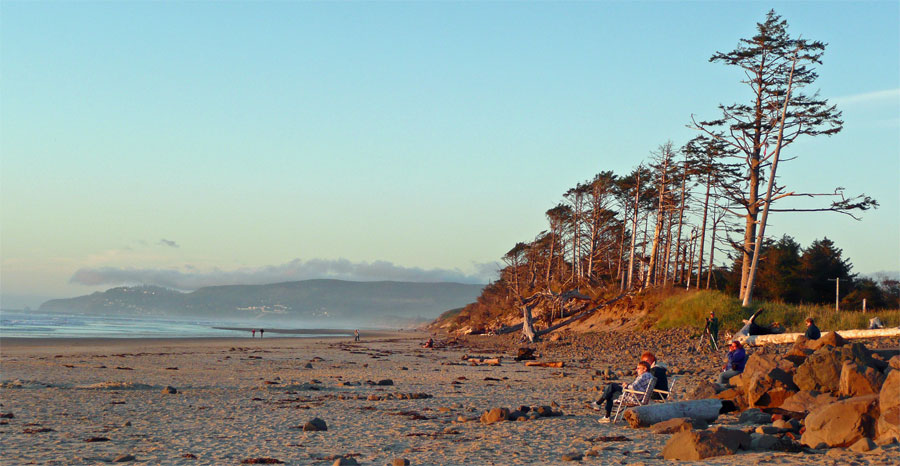
 anything but a
place of sanctuary or safety, the usual meaning of the word
anything but a
place of sanctuary or safety, the usual meaning of the word 



 to the 150 or so who continue to
live
in this half-ghost town (or “town frozen in time” as the brochures
say). We found a lovely blend of restored and
original wood and brick buildings, friendly people, nice shops, a
beautiful back bar and mirror at the Pioneer Bar, and a visitor’s
center that once housed a narrow gauge railroad that originally hauled
gold
ore but today carries tourists a couple of miles to Nevada City and
back. Several of the old businesses along Wallace Street look like the
owners just packed up and left one day, leaving their goods and window
displays as they were.
to the 150 or so who continue to
live
in this half-ghost town (or “town frozen in time” as the brochures
say). We found a lovely blend of restored and
original wood and brick buildings, friendly people, nice shops, a
beautiful back bar and mirror at the Pioneer Bar, and a visitor’s
center that once housed a narrow gauge railroad that originally hauled
gold
ore but today carries tourists a couple of miles to Nevada City and
back. Several of the old businesses along Wallace Street look like the
owners just packed up and left one day, leaving their goods and window
displays as they were. crushing
200 tons of ore per day. The twin chimneys stand tall above
the trees and giant brick
furnaces on a massive granite foundation. The flue still carries water
and several of the camp’s buildings still stand.
crushing
200 tons of ore per day. The twin chimneys stand tall above
the trees and giant brick
furnaces on a massive granite foundation. The flue still carries water
and several of the camp’s buildings still stand. anything but a
place of sanctuary or safety, the usual meaning of the word refuge.
My nephew, Doug, who lives in Idaho, explained this apparent
contradiction to me a few days later: “That’s Idaho.” Are there other
“refuges” that permit/encourage hunting, or are we naive?]
anything but a
place of sanctuary or safety, the usual meaning of the word refuge.
My nephew, Doug, who lives in Idaho, explained this apparent
contradiction to me a few days later: “That’s Idaho.” Are there other
“refuges” that permit/encourage hunting, or are we naive?] for
hiking and biking, plus fishing,
swimming,
lots of wildlife, and even an “airport” for model airplane buffs. The
3000-acre facility is one of the best state parks we found on the trip.
for
hiking and biking, plus fishing,
swimming,
lots of wildlife, and even an “airport” for model airplane buffs. The
3000-acre facility is one of the best state parks we found on the trip. hour in Idaho. On the Sunday we were there,
the clan gathered at Pam and Nil’s (all but two who had to work). Such
an occasion is both a periodic event as well as a once-in-a-while
command performance
for the family to meet their aunt and uncle (or great-, or
great-great-aunt and uncle). We’d not seen some of them in 15
years. The changes were remarkable,
though no one said that we looked older! There was food for an army
(including garlic knockers) and lots of pictures taken. They are a
good-looking bunch and fun to be with. All in all, it was a terrific
visit.
hour in Idaho. On the Sunday we were there,
the clan gathered at Pam and Nil’s (all but two who had to work). Such
an occasion is both a periodic event as well as a once-in-a-while
command performance
for the family to meet their aunt and uncle (or great-, or
great-great-aunt and uncle). We’d not seen some of them in 15
years. The changes were remarkable,
though no one said that we looked older! There was food for an army
(including garlic knockers) and lots of pictures taken. They are a
good-looking bunch and fun to be with. All in all, it was a terrific
visit. Evergreen
State” came from. As we came off White Pass
there was Mt. Rainier rising majestically from the surrounding hills.
What a beautiful and impressive sight, reminding us both of Jhomolhari
in Bhutan.
Evergreen
State” came from. As we came off White Pass
there was Mt. Rainier rising majestically from the surrounding hills.
What a beautiful and impressive sight, reminding us both of Jhomolhari
in Bhutan. next few days. We did stop
at Seaside,
an attractive
year-round tourist destination: restaurants,
souvenir shops, fudge makers, bumper cars—you get the idea. There is a
prominent statue of Lewis and Clark down by the end of the town walkway
that identifies Seaside as the terminus of their journey. We skipped by
Cannon Beach (a bit too ritzy
and residential), though we did take
shots of famous Haystack Rock, which, though often shown in travel
booklets, is like a lot of other large monoliths that line the Oregon
coast. We also skipped Manzanita
and Nehalem, which we’d come
back to
on another trip.
next few days. We did stop
at Seaside,
an attractive
year-round tourist destination: restaurants,
souvenir shops, fudge makers, bumper cars—you get the idea. There is a
prominent statue of Lewis and Clark down by the end of the town walkway
that identifies Seaside as the terminus of their journey. We skipped by
Cannon Beach (a bit too ritzy
and residential), though we did take
shots of famous Haystack Rock, which, though often shown in travel
booklets, is like a lot of other large monoliths that line the Oregon
coast. We also skipped Manzanita
and Nehalem, which we’d come
back to
on another trip. 
 We’ll go back there for sure. The Coquille
River
Lighthouse in the smallest of the eight remaining Oregon coast
lighthouses. We drove through the attractive town and out to the
highway via an area of posh beach homes that are being built as fast as
the guys can drive nails.
We’ll go back there for sure. The Coquille
River
Lighthouse in the smallest of the eight remaining Oregon coast
lighthouses. We drove through the attractive town and out to the
highway via an area of posh beach homes that are being built as fast as
the guys can drive nails. 
 and to look for the house that was used in the opening
sequence of
the TV series “Murder She Wrote.” The show’s fictional setting
was Maine, but Jessica’s house was actually filmed in Mendocino. A
short drive from town is a network of paths for walking, biking, and
running. It was a sparkling day, so Judy ran while Hughes and dogs
walked along the edge of the steep cliffs watching the sea birds and
waves.
and to look for the house that was used in the opening
sequence of
the TV series “Murder She Wrote.” The show’s fictional setting
was Maine, but Jessica’s house was actually filmed in Mendocino. A
short drive from town is a network of paths for walking, biking, and
running. It was a sparkling day, so Judy ran while Hughes and dogs
walked along the edge of the steep cliffs watching the sea birds and
waves.
 where William
Randolph Hearst built this famous playhouse for his rich friends, the
well-connected, and his mistress.
where William
Randolph Hearst built this famous playhouse for his rich friends, the
well-connected, and his mistress. 


 his property.
his property.


